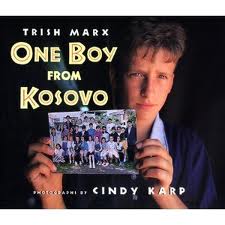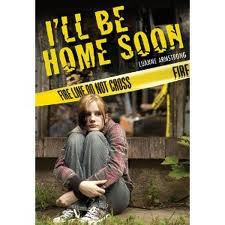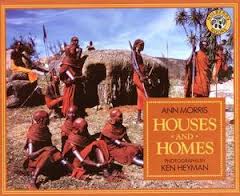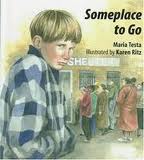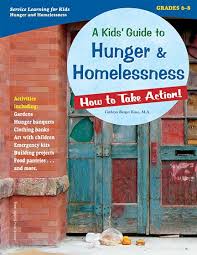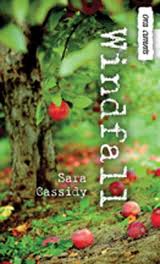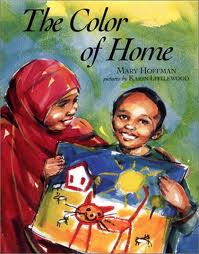One Boy from Kosovo by Trish MarxWhen war drove twelve-year-old Edi and his family from their home in Kosovo, they fled across the Macedonian border to the Brazda refugee camp, a tent city that housed almost thirty thousand people. There the family shared a tent with more than twenty other people, with no kitchen, no running water, and no school for Edi to attend. Instead he helped out with the younger kids, played soccer with the other boys, and ran errands, such as waiting in the long lines for food and fresh water. Everybody was waiting in Brazda -- for news about relatives, for the war to end, for the day when they could finally go home again.
|
I'll Be Home Soon by Luanne ArmstrongYoung Adult Fiction. In I'LL BE HOME SOON, Luanne Armstrong takes the reader on a tension-filled ride as Regan, a young girl living in the inner city, searches for her mother who has mysteriously disappeared. Homeless but by no means hapless, Regan is on her own much of the time but also receives help from a wide diversity of people: a young homeless boy like herself, her kung fu teacher, a university researcher, her grandmother, and a group of people who survive as bottle pickers. On the street, she must learn who it is she can truly trust, and it is not always those whom she (and the reader) might expect. Through her search for her mother, and in her connections with the people who truly help and care for her, Regan discovers her own inner strength and independence. In this fast-paced and sensitive story, Armstrong draws us into the shadowy and difficult side of inner-city life to show us both the dark and the compassionate sides of the people who survive in its midst.
|
Houses and Homes by Anne Morris and Ken HeymanThe world is full of houses. Big houses and little houses. Houses that stay in one place and houses that move from place to place. Some houses are made of wood or stone; others are made from mud or straw. But all of them are made for families to live in.
|
Someplace to Go by Maria TestaYoung Davey, his mother, and his older brother are living in a shelter and eating at a soup kitchen. The boys’ mother worked in a paper mill for most of her life until it closed two years earlier and has just recently been hired at a hospital laundry. If she can hold her job and 16-year-old Anthony can find work as well, they can begin to think about renting an apartment. After-school hours are challenging for Davey; he passes the time at a neighbourhood supermarket, the public library and walking the streets until the soup kitchen opens. He is an unassuming character whose home situation goes unnoticed by his classmates. The mood of this serious yet hopeful narrative is enhanced with expressive watercolour illustrations.
|
A Kid's Guide to Hunger and Homelessness: How to Take Action! by Cathryn Berger KayeKids explore what others in the world (including young people) have done and are doing to address the issues, find out what their community needs and develop a service project. The workbook includes facts, quotations, real-life examples, write-on pages, resources, a note to adults – and lots of inspiration to get out there and make a difference in the world. Includes exclusive interviews with author and activist Francis Moor Lappe and Lindsey Lee Johnson, author of Soul Moon Soup, the story of a girl living on the streets with her mother.
About the Author Cathryn Berger Kaye is an international service learning consultant and a former classroom teacher. She works with the state departments of education, university faculty and student, school districts, and classroom teachers on a variety of education issues such as service learning, civic responsibility, student leadership, and respectful school communities. She lives in Los Angeles with her husband and two daughters. |
Windfall by Sara CassidyThe homeless, apple trees, community gardening, the politics of food, coping with death and meeting cute boys are the themes of Sara Cassidy’s latest book, Windfall. Somehow, Sara Cassidy weaves these themes together producing a fast, entertaining read suitable for young teens. The novel is a first person narrative about Liza, a charming, idealistic and precocious 13-year-old coping with the death of a homeless man befriended by her family. Richard lived in the neighborhood park and spent most of his time sitting on a bench underneath an old apple tree. Liza’s family befriended Richard, offering him food and company occasionally. While Liza sorts through her guilt and remorse, she learns that Richard struggled to obtain fresh fruits and vegetables. Liza is also saddened by the possibility that she may lose a treasured apple tree in her family’s back yard. During a conversation with an arborist, Liza discovers that the apple tree is over 100 years old and part of an orchard planted when the area was a farm. A local historian describes the history of the region and the politics of food production. A sick apple tree, orchards and the lack of fresh fruits and vegetables for the homeless compel Liz to convene a meeting of her friends.
|
The Color of Home by Mary HoffmanThis remarkably moving picture book follows first-grader Hassan through his first few days at school. Hassan has only recently arrived in the United States after he and his family were forced to flee Somalia, and he deeply misses the colorful landscape of his former home in Africa. But with the help of his parents, an understanding teacher, and a school art project, Hassan finds that by painting a picture of his old home and sharing his story, his homesickness and the trauma of leaving a war-torn country are lessened. And he finds that there are many things to like about his new home in America. The colorful, impressionistic illustrations are a perfect complement to the wonderful text by Mary Hoffman, author of the highly acclaimed Amazing Grace. Together art and text make this poignant story accessible and affecting for a young audience.
|
